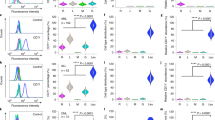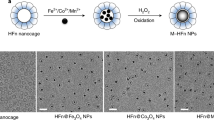Abstract
Nanoformulations, prodrugs, and targeted therapies are among the most intensively investigated approaches to new cancer therapeutics. Human ferritin has been used extensively as a nanocarrier for the delivery of drugs and imaging agents to cancerous tumor cells both in vitro and in vivo. We report exploitation of the native properties of ferritin, which can be co-loaded with simple forms of iron (FeOOH) and arsenic (arsenate) in place of the native phosphate. The As(III) form arsenic trioxide has been successfully used to treat one blood cancer, but has so far proven too systemically toxic for use on solid tumors in the clinic. The As(V) form, arsenate, on the other hand, while much less systemically toxic upon bolus injection has also proven ineffective for cancer therapy. We extended the C-terminal ends of the human ferritin subunits with a tumor cell receptor targeting peptide and loaded this modified ferritin with ~ 800 arsenates and ~ 1100 irons. Our results demonstrate targeting and uptake of the iron, arsenate-loaded modified human ferritin by breast cancer cells. At the same arsenic levels, the cytotoxicity of the iron, arsenate-loaded human ferritin was equivalent to that of free arsenic trioxide and much greater than that of free arsenate. The iron-only loaded human ferritin was not cytotoxic at the highest achievable doses. The results are consistent with the receptor-targeted human ferritin delivering arsenate as a reductively activated ‘prodrug’. This targeted delivery could be readily adapted to treat other types of solid tumor cancers.
Graphic abstract








Similar content being viewed by others
References
Liu JX, Zhou GB, Chen SJ, Chen Z (2012) Curr Opin Chem Biol 16:92–98
Swindell EP, Hankins PL, Chen H, Miodragovic DU, O'Halloran TV (2013) Inorg Chem 52:12292–12304
Hoonjan M, Jadhav V, Bhatt P (2018) J Biol Inorg Chem 23:313–329
Zangi R, Filella M (2012) Chem-Biol Interact 197:47–57
Ahn RW, Chen F, Chen H, Stern ST, Clogston JD, Patri AK, Raja MR, Swindell EP, Parimi V, Cryns VL, O'Halloran TV (2010) Clin Cancer Res 16:3607–3617
Zhao ZH, Zhang H, Chi XQ, Li H, Yin ZY, Huang DT, Wang XM, Gao JH (2014) J Mater Chem B 2:6313–6323
Zhao Z, Wang X, Zhang Z, Zhang H, Liu H, Zhu X, Li H, Chi X, Yin Z, Gao J (2015) ACS Nano 9:2749–2759
Wu X, Han Z, Schur RM, Lu Z-R (2016) ACS Biomater Sci Eng 2:501–507
Akhtar A, Wang SX, Ghali L, Bell C, Wen X (2017) J Biomed Res 31:177–188
Ebrahimi KH, Hagedoorn PL, Hagen WR (2015) Chem Rev 115:295–326
Polanams J, Ray AD, Watt RK (2005) Inorg Chem 44:3203–3209
Nemeti B, Gregus Z (2002) Toxicol Sci 70:4–12
Watt GD, Frankel RB, Papaefthymiou GC, Spartalian K, Stiefel EI (1986) Biochemistry 25:4330–4336
Liang M, Fan K, Zhou M, Duan D, Zheng J, Yang D, Feng J, Yan X (2014) Proc Natl Acad Sci USA 111:14900–14905
Hasan MR, Tosha T, Theil EC (2008) J Biol Chem 283:31394–31400
Masuda T, Goto F, Yoshihara T, Mikami B (2010) Biochem Biophys Res Commun 400:94–99
Truffi M, Fiandra L, Sorrentino L, Monieri M, Corsi F, Mazzucchelli S (2016) Pharmacol Res 107:57–65
Li L, Fang CJ, Ryan JC, Niemi EC, Lebron JA, Bjorkman PJ, Arase H, Torti FM, Torti SV, Nakamura MC, Seaman WE (2010) Proc Natl Acad Sci USA 107:3505–3510
Vannucci L, Falvo E, Fornara M, Di Micco P, Benada O, Krizan J, Svoboda J, Hulikova-Capkova K, Morea V, Boffi A, Ceci P (2012) Int J Nanomed 7:1489–1509
Zhen ZP, Tang W, Chen HM, Lin X, Todd T, Wang G, Cowger T, Chen XY, Xie J (2013) ACS Nano 7:4830–4837
Uchida M, Flenniken ML, Allen M, Willits DA, Crowley BE, Brumfield S, Willis AF, Jackiw L, Jutila M, Young MJ, Douglas T (2006) J Am Chem Soc 128:16626–16633
Lee JH, Seo HS, Song JA, Kwon KC, Lee EJ, Kim HJ, Lee EB, Cha YJ, Lee J (2013) ACS Nano 7:10879–10886
Lee EJ, Lee SJ, Kang YS, Ryu JH, Kwon KC, Jo E, Yhee JY, Kwon IC, Kim K, Lee J (2015) Adv Funct Mat 25:1279–1286
Roskoski R Jr (2014) Pharmacol Res 79:34–74
Park HS, Jang MH, Kim EJ, Kim HJ, Lee HJ, Kim YJ, Kim JH, Kang E, Kim SW, Kim IA, Park SY (2014) Modern Pathol 27:1212–1222
Nakajima H, Ishikawa Y, Furuya M, Sano T, Ohno Y, Horiguchi J, Oyama T (2014) Breast Cancer 21:66–74
Kalimutho M, Parsons K, Mittal D, Lopez JA, Srihari S, Khanna KK (2015) Trends Pharmacol Sci 36:822–846
Mickler FM, Mockl L, Ruthardt N, Ogris M, Wagner E, Brauchle C (2012) Nano Lett 12:3417–3423
Tang H, Chen X, Rui M, Sun W, Chen J, Peng J, Xu Y (2014) Mol Pharmaceut 11:3242–3250
Song S, Liu D, Peng J, Sun Y, Li Z, Gu JR, Xu Y (2008) Int J Pharmaceut 363:155–161
Tabor S (1990) In: Ausubel FA, Brent R, Kingston RE, Moore DD, Seidman JG, Smith JA, Struhl K (eds) Current protocols in molecular biology. Wiley, New York, pp 16.12.11–16.12.11
Baaghil S, Lewin A, Moore GR, Le Brun NE (2003) Biochemistry 42:14047–14056
Hirayama T, Okuda K, Nagasawa H (2013) Chem Sci 4:1250–1256
Lee BR, Ko HK, Ryu JH, Ahn KY, Lee YH, Oh SJ, Na JH, Kim TW, Byun Y, Kwon IC, Kim K, Lee J (2016) Sci Rep 6:35182
Ahmad S, Kitchin KT, Cullen WR (2000) Arch Biochem Biophys 382:195–202
Bienfait HF, van den Briel ML (1980) Biochim Biophys Acta 631:507–510
Ma Y, Chapman J, Levine M, Polireddy K, Drisko J, Chen Q (2014) Sci Transl Med 6:222ra218
Baj G, Arnulfo A, Deaglio S, Mallone R, Vigone A, De Cesaris MG, Surico N, Malavasi F, Ferrero E (2002) Breast Cancer Res Treat 73:61–73
Zhang L, Zhang Z, Mason RP, Sarkaria JN, Zhao D (2015) Sci Rep 5:9874
Miodragovic D, Swindell EP, Waxali ZS, Bogachkov A, O'Halloran TV (2019) Inorg Chim Acta 496:119030
Acknowledgements
This article is dedicated to the memory of Beth A. Goins. This research was supported by a Grant from the Cancer Prevention and Research Institute of Texas (RP110165). The Biophotonics Core facility and Flow Cytometry Core facility at the University of Texas at San Antonio (UTSA) are supported by a Grant from the National Institute on Minority Health and Health Disparities from the National Institutes of Health (G12MD007591). H. Shipley in the UTSA Department of Civil and Environmental Engineering, and K. Nash in the UTSA Department of Physics and Astronomy provided access to ICP-OES and DLS instrumentation, respectively.
Author information
Authors and Affiliations
Corresponding author
Ethics declarations
Conflict of interest
The authors declare no conflicts of interest.
Additional information
Publisher's Note
Springer Nature remains neutral with regard to jurisdictional claims in published maps and institutional affiliations.
Electronic supplementary material
Below is the link to the electronic supplementary material.
Rights and permissions
About this article
Cite this article
Cioloboc, D., Kurtz, D.M. Targeted cancer cell delivery of arsenate as a reductively activated prodrug. J Biol Inorg Chem 25, 441–449 (2020). https://doi.org/10.1007/s00775-020-01774-3
Received:
Accepted:
Published:
Issue Date:
DOI: https://doi.org/10.1007/s00775-020-01774-3




